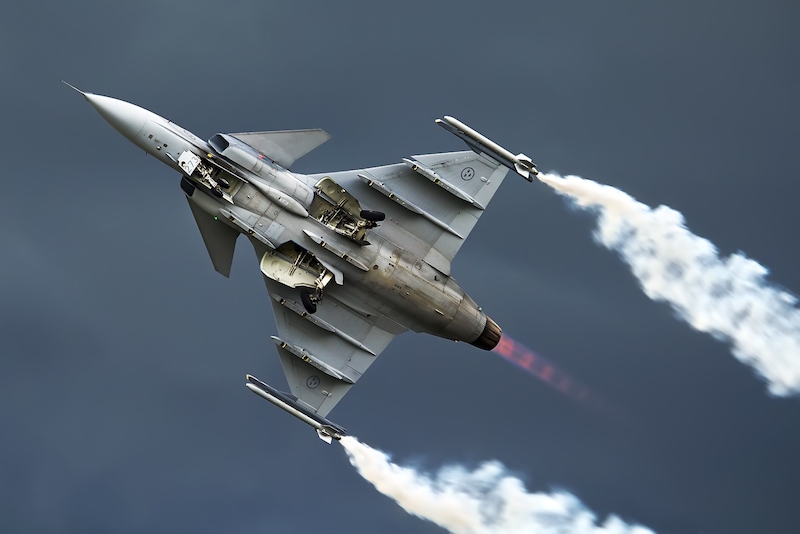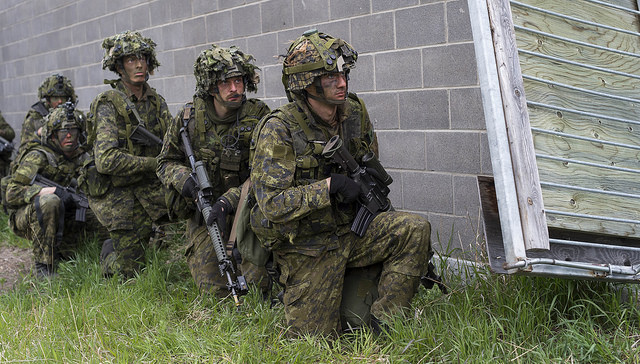In late 2016, the Royal Canadian Air Force (RCAF) announced a plan to replace its ageing fighter jet fleet of CF-18 aircrafts, which is more than thirty years old. The Trudeau government will initiate an open competition to replace the CF-18s, while the RCAF is currently in the process of acquiring 18 new Boeing F/A-18 E/F Super Hornets to serve as an interim fleet to bridge the ‘capability gap’. This breaks away from the promise made by the Harper government in 2010 of buying 65 F-35s from Lockheed Martin. Among the fighter aircrafts which are likely to be considered is the Swedish SAAB Gripen E/F, which would be a great fit for the RCAF if used along with the F-35 Joint Strike Fighters.
Canada’s Missions
Before exploring the reasons the Gripen would be an effective replacement for the CF-18s, it is necessary to analyze the crucial missions for which Canada is currently using its CF-18s. First, is Canada’s commitment to NORAD, which is tasked with monitoring and protecting North American airspace. Canada also contributes to NATO operations across the world, and is currently active in Eastern Europe. In 2014, Canada was responsible for monitoring the Baltic countries’ airspace as the head of the NATO Baltic Air Policing Mission (BAP). In addition, Canada has recently deployed a battalion in Latvia in order to reinforce the country’s defences in the face of Russia’s bellicosity. Finally, Canada has used some of its CF-18s to contribute to the Global Coalition against ISIS in Iraq and Syria (Operation IMPACT).
In these missions, Canada is faced with both conventional and unconventional threats in varying weather conditions. Therefore, the RCAF must be ready to face conventional armies and fighter fleets, to effectively operate against insurgents or terrorists, and to render anti-access/area-denial (A2/AD) strategies ineffective. In order to accomplish all these tasks, the RCAF must acquire a mixed fighter fleet made up of F-35s and Gripens.
Mixing the Fighter Fleet
Forming a mixed fighter fleet combining F-35s and E/F Gripens is the best option for Canada if it wants to face the challenges of today and tomorrow. The F-35 is currently the finest jet fighter on the market when it comes to stealth missions. If employed by the RCAF, it would be capable of countering A2/AD bubbles, and to penetrate enemy defenses with greater ease than the Gripen. Furthermore, if facing an enemy fleet unable to spot the F-35, the latter would ensure Canada’s domination of the sky.
In turn, the Gripen is more versatile than the F-35, and has great weapon flexibility. It may even be equipped with the MBDA Meteor BVRAAM missile, which can shoot down airborne threats from more than 100km away. The Gripen may be used in various operations, whether in air-to-air or air-to-ground combat, in the Arctic or in the Middle East. Its small size, its speed, and its 27 mm Mauser BK27 cannon coupled with the Gripen’s Electronic Warfare System and Infrared Search and Track abilities, make it particularly lethal when it comes to dogfights and air-to-air fighting. In addition, the Gripen is highly interoperable and fit for reconnaissance missions thanks to its data link system. Choosing the Gripen to replace the ageing CF-18s would bolster the NORAD and Canadian NATO deployments.
Seeing the challenges Canada is soon likely to face, it seems necessary for the RCAF to develop a mixed fighter fleet. Only relying on F-35s, or on Gripens will not suffice to counter tomorrow’s challenges.
Why the Gripen?
The ultimate question is whether Canada will choose the Gripen over other fighters such as the Super Hornet to complement its mixed fighter fleet. In comparison to other jet fighters, the Gripen has important advantages. It is relatively cheap compared to the French Rafale or the F-35, and its operational costs are lower than that of all other Western fighter jets. The Gripen may be deployed to areas where military facilities are underdeveloped, since it can take off from small runways due to its high flexibility, and can operate in all types of weather. This makes the Gripen a perfect fit for Canadian military missions, especially in the Arctic and for deployments abroad as part of NATO. In addition, it is possible to refuel the jet in the air through a “probe and drogue” system, as currently used for the CF-18s. This ensures greater autonomy when conducting operations. The Gripen’s high weapon flexibility also means it can adapt its payload depending on the mission, and can thus excel in surveillance missions, or air-to-air and air-to-ground combat.
In 2013, Brazil ordered 36 Gripens E/F from SAAB, which will be built jointly in Sweden and Brazil. The industrial cooperation and transfer of technologies from SAAB Industries to Brazil, along with the creation of a Gripen E/F maintenance centre in Brazil, is a long-term source of jobs for Brazil’s industries. Canada could benefit greatly from such a deal, as it would boost its aerospace industry while at the same time ensure total operational independence once the Gripens are combat-ready.
The Gripen is a perfect candidate for the open-competition initiated by the Trudeau government, and acquiring a joint fleet made up of F-35s and Gripens E/F would ensure Canadian control of the skies for decades to come.
Photo: SAAB JAS-39C Gripen, the predecessor of the Gripen E/F (2012), by Oleg V. Belyakov-AirTeamImages via Wikimedia Commons. Licensed under CC BY-SA 3.0.
Disclaimer: Any views or opinions expressed in articles are solely those of the authors and do not necessarily represent the views of the NATO Association of Canada.



